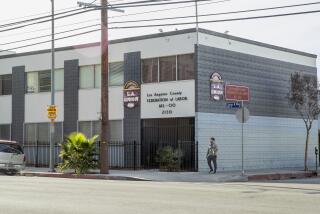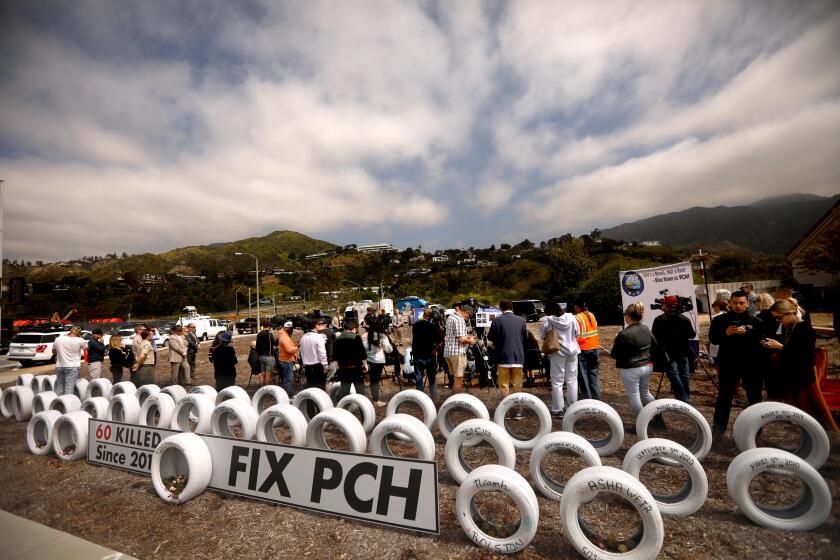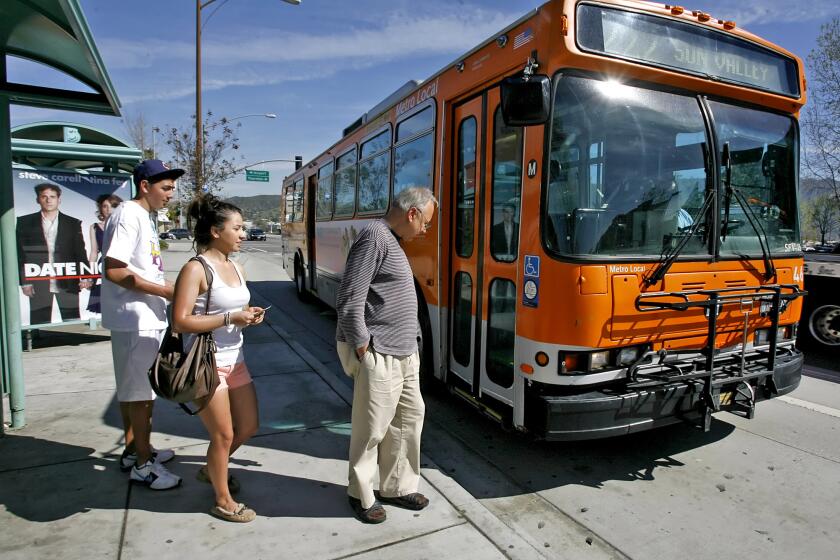Ed Longley Never Met a Street He Didn’t Like : L.A.’s No. 1 Pothole Plugger Will Retire Today
After 5 million potholes (give or take a few hundred thousand), the Edward D. Longley era comes to an end at City Hall today.
Longley, 59, director of the Bureau of Street Maintenance for 11 years, will retire today after 38 years as a city employee, 31 of them with the bureau. That pothole reference translates thus: The bureau keeps statistics down to the teeniest crack in the pavement on the number of potholes it plugs daily. The average for the two most recent years was 148,375.
Pothole repair is the most visible evidence of the bureau’s productivity although, as an arm of the Department of Public Works, it does everything from chopping down tree limbs that obstruct traffic signs to reconstructing boulevards.
He insists that he has no favorites, but Ed Longley concedes that he has never met a Los Angeles street he didn’t like. “This may sound corny, but I like them all because each one has its own distinct character.”
“I’ve got a Thomas map book in my head,” he said. “When someone mentions a location to me, I say, ‘Let me think a second,’ and a visual image just sort of takes over.”
Consider the scope of the agency he ran:
- Its purview is the largest street system in the nation, 7,600 miles of roadways and alleys.
- Its budget is $75 million annually, and it employs 1,500 workers.
- It is divided into 24 districts, one of which, Hollywood, is where Longley began working for the agency as a street maintenance foreman, or supervisor as the job is called today.
- It is also split into four divisions: Street Maintenance, which is responsible for maintaining and cleaning the huge arterial network; Lot Cleaning, which eradicates weeds and removes debris from public property, plus 25,000 private, unimproved lots (owners are assessed for the work on their tax bills); Street Use Inspection, which oversees enforcement of 70 municipal ordinances that govern such diverse matters as house moving and upkeep of benches at bus stops, and the Street Tree Division, which tends more than 700,000 trees on public property, as well as plantings on median strips.
The man who has overseen this vast movable workshop since the mid-70s is a tall, crew-cut Los Angeles native, the son of a former Canadian Mountie who moved here in 1920 and later became an engineer for the Department of Water and Power.
Longley traces his fascination with the city’s broad boulevards and hidden byways back to his boyhood. When he was 12 and living in Hollywood, his mother bought him a summer pass that allowed him to ride endlessly, to the beaches and the Valley, on the old Red and Yellow cars (“one of the things she used to do to keep me out of trouble”).
As bureau director, the tracks that once carried those light-rail cars represented more than nostalgia to Longley; they constituted just another pain in the asphalt for him and his subordinates. When the lines were abandoned, 700 miles of tracks were paved over in the city. “Now when the rails corrode and the ties rot,” he said, “we have problems in the center of the street.”
Problems have been his daily ration, but associates say he confronts them with an unflappable air and an innovative spirit.
“His whole life has been the streets,” said a close friend of 15 years, Mike McKelvey, secretary of the Department of Public Works. “Where he’s invaluable is in emergencies. He doesn’t abide by bureaucratic rules. Most bureaucrats--like me--say, ‘OK, we’ll have to take a look at this before we move.’ But he takes a positive approach that things can be done.”
Said Tom LaBonge, field deputy for Councilman John Ferraro: “He’s the best friend at City Hall of the City Council field deputy. You can call him with a constituent’s complaint and you’ll know he’ll get the problem handled.”
Both LaBonge and McKelvey said Longley’s intimate knowledge of the city’s multifarious streets has been one of his great assets.
McKelvey, who rode to work with Longley for several years, said he used to enjoy “testing” his friend. “I’d find a strange or obscure street name--and we’ve got some in this town--and I’d say, ‘OK, Ed, where is this?’ And right away he’d pinpoint it. He can tell you what’s the only concrete street left in a given neighborhood or where the ones are that shoot off at a 30-degree angle.”
Laughing, McKelvey added, “He also knows every great chili dog spot in L.A.”
McKelvey observed that Longley has saved the city many dollars with innovative thinking. “A few years ago, he realized when the time had come for the bureau to be more equipment-intensive than manpower-intensive,” McKelvey said. “And it’s paid off.”
For example, until three years ago, work crews were able to get around to city trees only once every 12 to 15 years unless there was an emergency. Longley started using hydraulic lifts, which made trimming much faster than physically climbing the trees. And instead of cutting the tree limbs up into small chips on the site, the limbs are now loaded into large trucks and taken to landfills, saving more time. Now the crews can take care of all the trees every 6 1/2 half years.
Longley has also persuaded equipment manufacturers to use Los Angeles as a testing ground for newfangled street repair and cleaning prototypes at no cost. One type of high-tech paving equipment has enabled the bureau to increase resurfacing to 212 miles yearly contrasted with only 50 to 60 miles in 1977, Longley said.
It has not been uncommon for him to work nights and weekends. “It’s a morale booster for the men on the street,” he said. “Being on a night crew is the loneliest job in the world, sweeping 40 miles of street and dodging cars and whatever else there is to dodge. I just want them to know someone cares about them.”
“It’s been a challenge,” he said of his work, which he plans to continue to some extent as a consultant. “Every day there’s something new. I’m a property owner and a taxpayer myself. So I want to see that the taxpayer gets his money’s worth. I want to see that our streets are clean and maintained.”
Longley contends that the streets of Los Angeles are cleaner today than they were 30 years ago, but he notes that “litter doesn’t generate itself.” He says that downtown is an especially difficult area to keep clean because 1 million people pass through it every 24 hours. He added that an influx of immigrants from countries where “littering seems to be OK” compounds the problem.
The same meticulous ethic Longley brought took to his $84,000-a-year job has carried over to his home life. No matter what was on the agenda for the weekend, his first priority has been to trim the lawn of his San Fernando Valley home, where he has lived for more than 30 years. “It has to be manicured,” he said. “It’s not my nature to let anything deteriorate.”
Least of all the crew cut, which he has had all his life. It sticks up an inch above his scalp at front, stiff as brambles, and it is his trademark around City Hall. “Right after I got married (35 years ago), my wife said, ‘Why don’t you let it grow out?’ After the second week, she said, ‘Get it cut.’ ”
More to Read
Start your day right
Sign up for Essential California for news, features and recommendations from the L.A. Times and beyond in your inbox six days a week.
You may occasionally receive promotional content from the Los Angeles Times.






